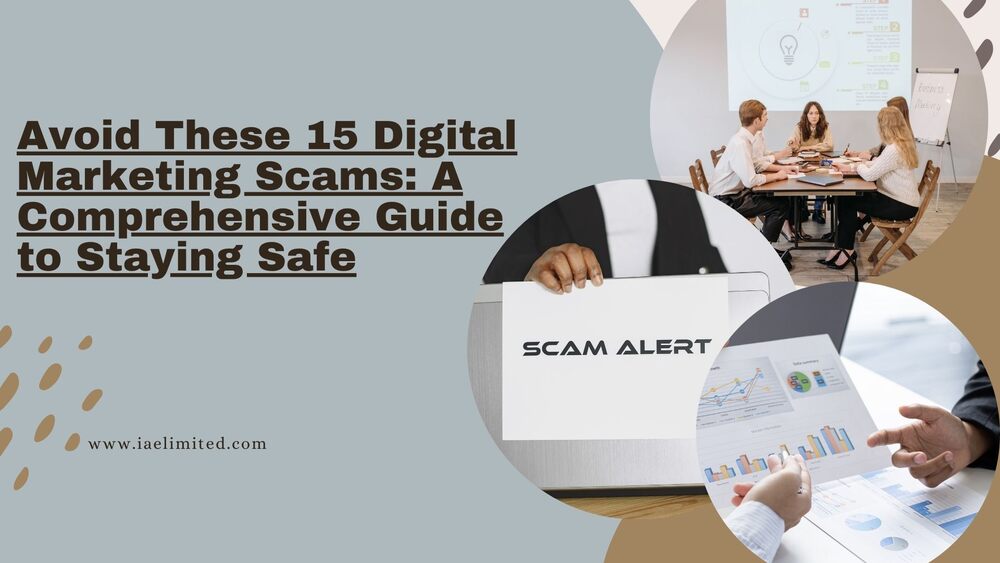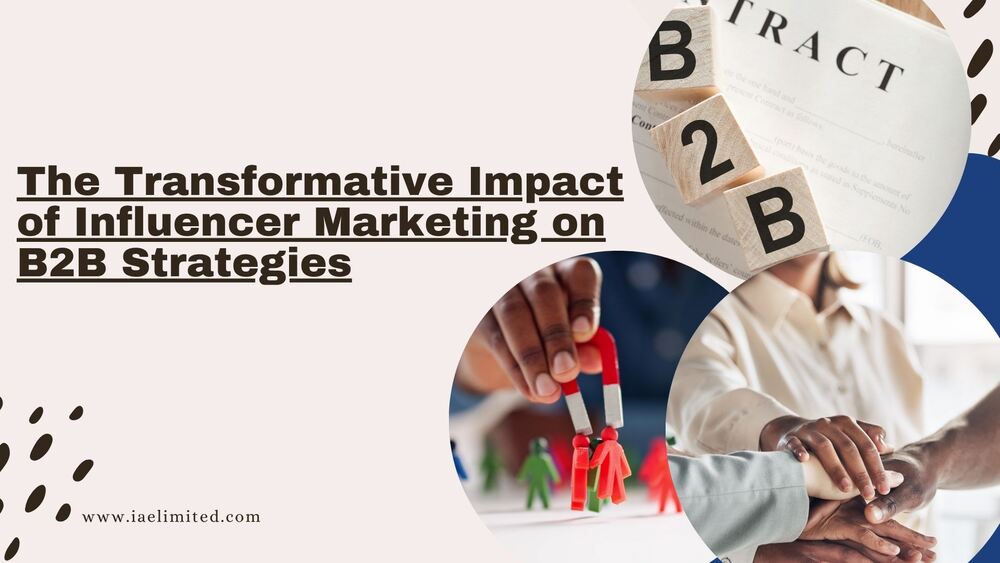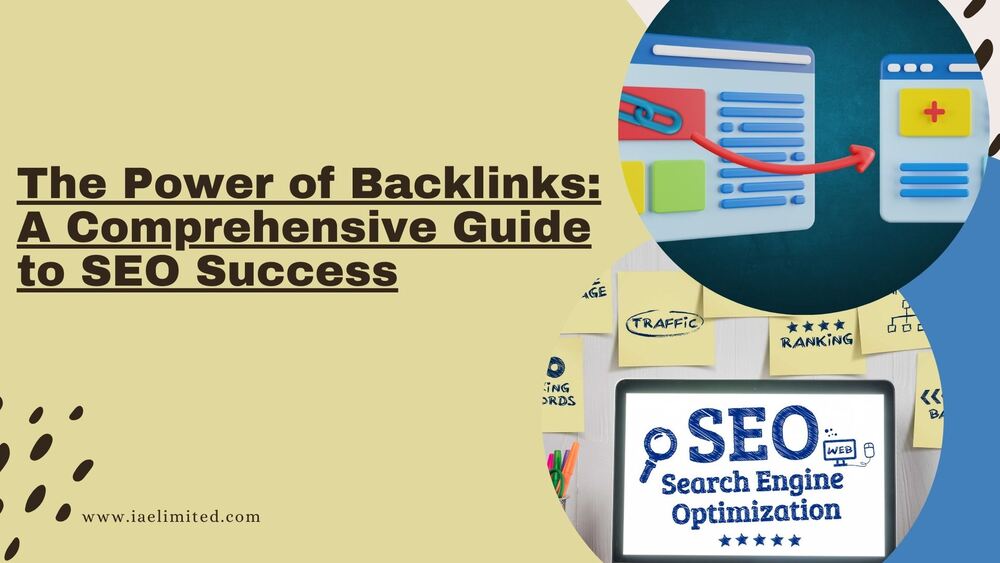Comprehensive Guide: 84 Essential Digital Marketing Interview Questions and Answers for 2024
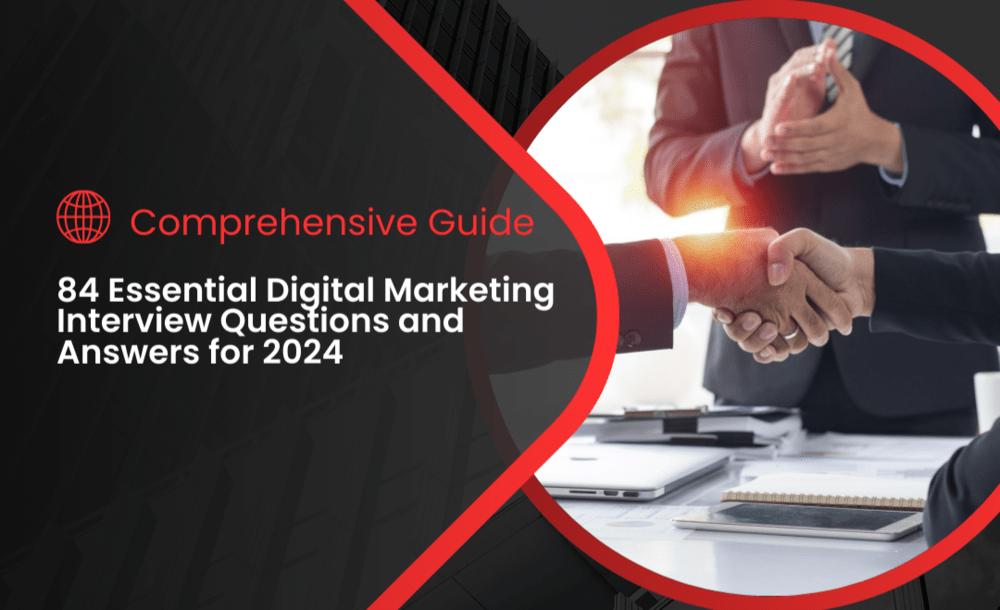
Introduction
Table of Contents
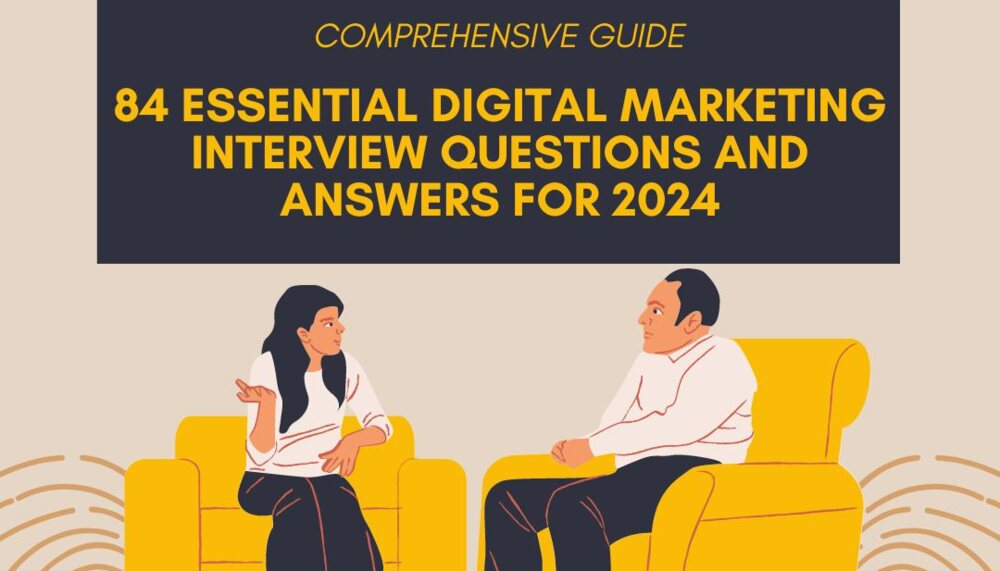
In today’s fast-paced digital world, staying ahead of the curve is essential for any digital marketing professional. Whether you’re an experienced marketer or just starting, acing a digital marketing interview requires not only knowledge but also the ability to articulate your understanding effectively.
In this article, we will explore 70 crucial digital marketing interview questions and answers that will help you prepare for your next job interview in 2024.
Section 1: General Digital Marketing Questions
Basic Concepts
Q1: What is Digital Marketing?
Digital marketing is the practice of promoting products or services using digital channels such as search engines, social media, email, and websites. It encompasses various strategies, including SEO, content marketing, and PPC.
Q2: How does Digital Marketing differ from Traditional Marketing?
Traditional marketing involves offline channels like TV, radio, and print, while digital marketing leverages online platforms. Digital marketing allows for more targeted, measurable, and interactive campaigns.
Q3: What are the key components of Digital Marketing?
The key components include SEO, content marketing, social media marketing, email marketing, SEM, and analytics. Each plays a vital role in driving traffic, engagement, and conversions.
Industry Trends
Q4: What are the current trends in Digital Marketing?
Trends include AI-driven marketing, personalized customer experiences, voice search optimization, and the rise of video content.
Q5: How is AI changing the landscape of Digital Marketing?
AI is automating tasks like content creation, customer segmentation, and ad targeting, making marketing more efficient and personalized.
Q6: What impact has social media had on Digital Marketing strategies?
Social media has revolutionized how brands interact with their audience, enabling real-time communication, brand storytelling, and targeted advertising.
Section 2: SEO (Search Engine Optimization) Questions
Core SEO Concepts
Q7: What is SEO, and why is it important?
SEO stands for Search Engine Optimization, a strategy used to improve a website’s visibility on search engines like Google. It’s crucial for driving organic traffic and increasing online visibility.
Q8: What are the key ranking factors in SEO?
Key factors include high-quality content, backlinks, mobile-friendliness, page speed, and user experience.
Q9: Explain the difference between on-page and off-page SEO.
On-page SEO involves optimizing elements on your website, like content and meta tags. Off-page SEO focuses on external factors, such as backlinks from other sites.
Technical SEO
Q10: What is technical SEO, and why is it crucial?
Technical SEO refers to optimizing the technical aspects of a website, like site speed, mobile optimization, and crawlability, to improve search engine rankings.
Q11: How do you perform a technical SEO audit?
An audit involves checking site speed, mobile responsiveness, indexing, security (HTTPS), and the presence of broken links.
Q12: What are canonical tags, and why are they used?
Canonical tags tell search engines which version of a URL to index, preventing duplicate content issues.
Content Optimization
Q13: How do you optimize content for search engines?
Optimization involves keyword research, using keywords naturally in content, optimizing meta descriptions and titles, and ensuring content is valuable and relevant.
Q14: What is keyword research, and how do you perform it?
Keyword research is identifying popular terms people use in search engines. It’s done using tools like Google Keyword Planner, Ahrefs, or SEMrush to find relevant keywords with high search volume and low competition.
Q15: Explain the importance of meta descriptions and title tags.
Meta descriptions and title tags are HTML elements that summarize the content of a page. They influence click-through rates and help search engines understand the page content.
Section 3: SEM (Search Engine Marketing) Questions
Basics of SEM
Q16: What is SEM, and how does it differ from SEO?
SEM (Search Engine Marketing) involves paid advertising to appear on search engine results pages. Unlike SEO, which is organic, SEM is a paid strategy.
Q17: What are Google Ads, and how do they work?
Google Ads is a platform where advertisers bid on keywords to display ads on Google search results. Ads are shown based on the Quality Score and bid amount.
Q18: Explain the concept of Quality Score in Google Ads.
Quality Score is a measure of the relevance and quality of your ads, keywords, and landing pages. A higher Quality Score can lower the cost-per-click and improve ad positioning.
Campaign Management
Q19: How do you set up a successful SEM campaign?
Setting up a campaign involves defining goals, selecting relevant keywords, creating compelling ad copy, and setting a budget and bid strategy.
Q20: What are the best practices for managing PPC campaigns?
Best practices include regularly monitoring performance, optimizing ad copy, adjusting bids, and using A/B testing to improve results.
Q21: How do you measure the success of an SEM campaign?
Success is measured through metrics like click-through rate (CTR), conversion rate, cost-per-click (CPC), and return on ad spend (ROAS).
Section 4: Social Media Marketing Questions
Social Media Platforms
Q22: What are the most popular social media platforms for marketing?
The most popular platforms include Facebook, Instagram, LinkedIn, Twitter, and TikTok.
Q23: How do you choose the right platform for a specific audience?
Choosing the right platform involves understanding where your target audience spends their time and aligning it with your marketing goals.
Q24: What are the benefits of using social media for marketing?
Benefits include increased brand awareness, customer engagement, lead generation, and access to real-time customer feedback.
Strategy Development
Q25: How do you create a social media marketing strategy?
Creating a strategy involves setting goals, identifying your target audience, choosing the right platforms, creating a content calendar, and measuring performance.
Q26: What are the key metrics to track in social media marketing?
Key metrics include engagement rate, follower growth, click-through rate, and conversion rate.
Q27: How do you handle negative feedback on social media?
Handling negative feedback requires responding quickly, acknowledging the issue, and offering a solution or apology to maintain a positive brand image.
Content Creation and Engagement
Q28: What types of content work best on social media?
Effective content includes videos, infographics, user-generated content, and stories that are visually engaging and shareable.
Q29: How do you increase engagement on social media posts?
Increasing engagement involves creating valuable content, using strong calls-to-action, engaging with your audience, and posting at optimal times.
Q30: What is the role of influencers in social media marketing?
Influencers can amplify your brand’s reach, build trust with your audience, and generate content that resonates with their followers.
Section 5: Content Marketing Questions
Fundamentals of Content Marketing
Q31: What is content marketing, and why is it important?
Content marketing involves creating and distributing valuable content to attract and engage a target audience, ultimately driving profitable customer action.
Q32: How do you create a content marketing plan?
Creating a plan involves setting objectives, identifying your target audience, developing a content calendar, and distributing content across appropriate channels.
Q33: What are the different types of content used in marketing?
Types include blog posts, videos, podcasts, infographics, eBooks, and case studies.
Content Distribution
Q34: How do you distribute content effectively?
Effective distribution involves leveraging multiple channels such as social media, email, and SEO, as well as partnerships and paid promotion.
Q35: What role does SEO play in content marketing?
SEO helps your content reach a wider audience by ensuring it ranks well on search engines, driving organic traffic to your site.
Q36: How do you measure the success of a content marketing strategy?
Success is measured through metrics like website traffic, engagement rates, lead generation, and conversion rates.
Blogging and Guest Posting
Q37: What are the benefits of blogging for a business?
Blogging boosts SEO, establishes authority in your industry, and provides valuable content that attracts and engages your target audience.
Q38: How do you write a successful blog post?
A successful blog post is well-researched, optimized for SEO, and provides value to the reader, with clear headings and a strong call to action.
Q39: What is guest posting, and how does it benefit SEO?
Guest posting involves writing content for other websites, which helps build backlinks to your site, boosting SEO and expanding your reach.
Section 6: Email Marketing Questions
Basics of Email Marketing
Q40: What is email marketing, and why is it effective?
Email marketing is the practice of sending targeted emails to prospects and customers. It’s effective due to its direct approach and high ROI.
Q41: How do you build an email marketing list?
Building a list involves using lead magnets, opt-in forms, and ensuring compliance with data protection regulations.
Q42: What are the key elements of a successful email campaign?
Key elements include a compelling subject line, personalized content, a clear call-to-action, and mobile optimization.
Email Campaign Management
Q43: How do you segment an email list?
Segmentation involves dividing your list into groups based on criteria like demographics, purchase history, or engagement level.
Q44: What are the best practices for email subject lines?
Best practices for email subject lines include being clear and concise, creating a sense of urgency or curiosity, and personalizing the subject line to the recipient.
Q45: How do you measure the success of an email marketing campaign?
Success is measured by metrics such as open rates, click-through rates, conversion rates, and overall ROI.
Automation and Personalization
Q46: What is email automation, and how does it work?
Email automation involves setting up pre-defined workflows that send emails based on specific triggers, such as subscriber actions or important dates. This ensures timely and relevant communication.
Q47: How do you personalize email content for better engagement?
Personalization can be achieved by using recipient names, segmenting lists to tailor content to interests, and providing relevant recommendations based on previous interactions.
Q48: What are drip campaigns, and how are they used in email marketing?
Drip campaigns are automated sequences of emails sent to leads or customers over time, designed to nurture relationships, educate, or guide them through a sales funnel.
Section 7: Analytics and Data Interpretation Questions
Understanding Digital Marketing Metrics
Q49: What are the most important metrics in digital marketing?
Important metrics include traffic sources, conversion rates, cost per acquisition (CPA), return on investment (ROI), and customer lifetime value (CLV).
Q50: How do you track and report on marketing performance?
Tracking and reporting involve using analytics tools like Google Analytics, creating dashboards, and regularly reviewing key metrics to assess campaign effectiveness.
Q51: What is the role of KPIs in digital marketing?
Key Performance Indicators (KPIs) measure the success of specific marketing objectives, helping to evaluate performance and guide strategic decisions.
Tools and Software
Q52: What tools do you use for digital marketing analytics?
Common tools include Google Analytics, SEMrush, Ahrefs, HubSpot, and social media analytics platforms.
Q53: How do you set up Google Analytics for a website?
Setting up Google Analytics involves creating an account, adding a tracking code to your website, and configuring goals and filters to track specific actions.
Q54: What is the difference between Google Analytics 4 and Universal Analytics?
Google Analytics 4 offers advanced tracking capabilities, integrates with Google Ads, and uses an event-based data model, while Universal Analytics is based on sessions and pageviews.
Data-Driven Decision Making
Q55: How do you use data to inform marketing decisions?
Data informs decisions by providing insights into customer behavior, campaign performance, and market trends, enabling more targeted and effective strategies.
Q56: What is A/B testing, and how is it implemented?
A/B testing involves comparing two versions of a webpage or ad to determine which performs better. It’s implemented by splitting traffic between the variants and analyzing the results.
Q57: Explain the importance of customer segmentation in data analysis.
Customer segmentation allows for targeted marketing efforts by grouping customers based on characteristics like behavior, demographics, or purchasing history, leading to more personalized campaigns.
Section 8: Conversion Rate Optimization (CRO) Questions
Fundamentals of CRO
Q58: What is Conversion Rate Optimization (CRO)?
CRO is the process of improving the percentage of visitors who complete a desired action on a website, such as making a purchase or signing up for a newsletter.
Q59: How do you identify conversion opportunities on a website?
Conversion opportunities are identified through analytics, user feedback, and testing, focusing on areas with high traffic but low conversion rates.
Q60: What are the best practices for improving conversion rates?
Best practices include optimizing landing pages, simplifying navigation, improving site speed, and using clear calls-to-action.
Testing and Optimization
Q61: How do you conduct A/B testing for CRO?
A/B testing involves creating two versions of a webpage or element, splitting traffic between them, and analyzing performance to determine which version yields better results.
Q62: What tools are used for CRO testing?
Popular tools for CRO testing include Optimizely, VWO (Visual Website Optimizer), and Google Optimize.
Q63: How do you analyze the results of CRO tests?
Results are analyzed by comparing metrics like conversion rates, bounce rates, and average session duration between the test variants.
User Experience (UX) and CRO
Q64: How does UX impact conversion rates?
Good UX enhances user satisfaction and reduces friction, leading to higher conversion rates by making it easier for users to navigate and complete desired actions.
Q65: What role does website design play in CRO?
Website design affects user engagement and conversion rates by influencing aesthetics, usability, and the overall user experience.
Q66: How do you optimize landing pages for conversions?
Landing page optimization involves using clear headlines, compelling visuals, strong calls-to-action, and ensuring a seamless user experience.
Section 9: Paid Advertising Questions
Understanding Paid Advertising
Q67: What are the different types of paid advertising in digital marketing?
Types include search ads, display ads, social media ads, and video ads, each offering different targeting options and placements.
Q68: How do you create a budget for paid advertising?
Creating a budget involves analyzing past performance, determining your goals, setting bid amounts, and allocating funds across different campaigns based on priority.
Q69: What are the benefits and drawbacks of paid vs. organic marketing?
Paid marketing offers immediate results and precise targeting but requires ongoing investment. Organic marketing builds long-term value and credibility but takes more time to achieve results.
Platforms and Strategies
Q70: What are the most effective platforms for paid advertising?
Effective platforms include Google Ads, Facebook Ads, LinkedIn Ads, and Instagram Ads, each suited to different types of campaigns and audiences.
Q71: How do you target the right audience for paid ads?
Targeting involves using demographic, geographic, and behavioral data to ensure ads reach the most relevant audience segments.
Q72: What are retargeting ads, and how do they work?
Retargeting ads are displayed to users who have previously interacted with your website or app, reminding them of your brand and encouraging return visits.
Ad Performance Measurement
Q73: How do you measure the effectiveness of paid ads?
Effectiveness is measured through metrics like click-through rate (CTR), conversion rate, cost-per-click (CPC), and return on ad spend (ROAS).
Q74: What metrics are important in evaluating paid advertising campaigns?
Important metrics include CTR, CPC, conversion rate, ROAS, and overall campaign ROI.
Q75: How do you optimize ad campaigns for better ROI?
Optimization involves adjusting bids, refining targeting, testing ad creatives, and analyzing performance data to improve results and maximize ROI.
Section 10: Emerging Trends and Future of Digital Marketing
Artificial Intelligence and Automation
Q76: How is AI transforming digital marketing?
AI enhances digital marketing by automating processes, personalizing content, optimizing ad targeting, and providing insights through advanced data analysis.
Q77: What role does automation play in marketing?
Automation streamlines repetitive tasks, such as email campaigns and social media posting, allowing marketers to focus on strategy and creativity.
Q78: What are the ethical considerations in AI-driven marketing?
Ethical considerations include data privacy, transparency, and avoiding biases in AI algorithms that could affect user experience and trust.
Voice Search and Smart Devices
Q79: What is voice search, and how does it impact SEO?
Voice search allows users to search using voice commands, affecting SEO by emphasizing natural language queries and optimizing for voice-friendly keywords.
Q80: How do smart devices influence digital marketing strategies?
Smart devices drive new opportunities for marketing through voice search, IoT integrations, and personalized interactions, requiring adaptation to new user behaviors.
Q81: What are the challenges of marketing in the age of smart technology?
Challenges include ensuring compatibility with various devices, addressing privacy concerns, and adapting to rapidly evolving technology trends.
Personalization and Customer Experience
Q82: Why is personalization important in digital marketing?
Personalization enhances user experience by providing relevant content and offers based on individual preferences and behaviors, leading to higher engagement and conversions.
Q83: How do you create personalized marketing campaigns?
Creating personalized campaigns involves segmenting your audience, using dynamic content, and leveraging data to tailor messages and offers.
Q84: What is the future of customer experience in digital marketing?
The future focuses on creating seamless, personalized experiences through advanced technology, data-driven insights, and continuous engagement with customers.
Conclusion
Preparing for a digital marketing interview in 2024 involves understanding a wide range of topics, from SEO and SEM to social media and content marketing. By mastering these 70 questions and answers, you’ll be well-equipped to demonstrate your expertise and land your dream job in digital marketing.
FAQs
Q: What are the most common questions in a digital marketing interview?
Common questions include those about SEO best practices, SEM strategies, social media metrics, and content marketing tactics.
Q: How should you prepare for a digital marketing interview?
Preparation involves researching the company, understanding their digital marketing strategies, and practicing answers to common interview questions.
Q: What skills are essential for a digital marketing professional in 2024?
Essential skills include SEO, SEM, social media management, content creation, data analysis, and proficiency with digital marketing tools.
Q: How do you stay updated with the latest digital marketing trends?
Stay updated by following industry blogs, attending webinars and conferences
